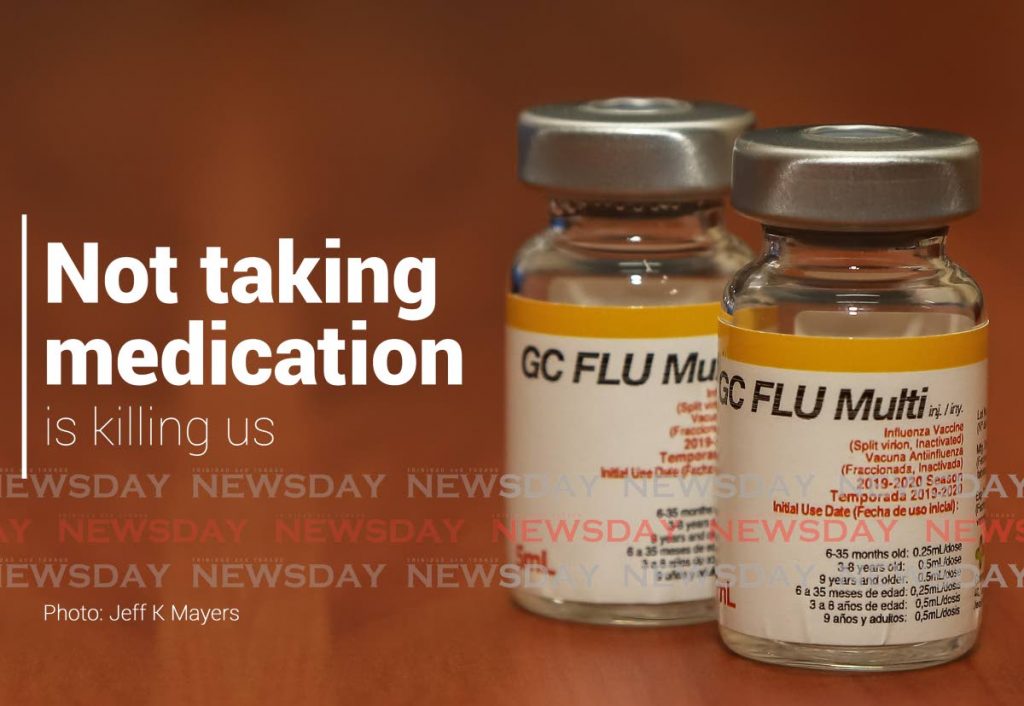
kmmpub@gmail.com
Fear of flu and infection has gripped headlines faster than a relatively-swiftly-moving zombie horde. Quite rightly, too – it is deadly serious, with babies numbering among more than a dozen people dead from viruses easily prevented by a simple vaccine.
Dig just a little deeper and we are swiftly confronted by the true scale of the problem.
One in two people die from heart disease, strokes and diabetes. Those three diseases alone cost us $6.8 billion a year, according to the Inter-American Development Bank. That is more than 4.5 per cent of GDP – roughly the same as Heritage Petroleum’s annual revenue. It is no accident that these diseases are the ones that most require medication to be controlled.
A few pioneers like pharmacologist Prof Lexley Pinto-Pereira have brought the issue to the fore. As recently as 2016, a study by Prof Mandrekar Bahall discovered that more than 49.5 per cent of prescriptions went unfilled – and this was in the public sector, where medication is ostensibly freely available.
Data remains sparse, but the challenge is comparably worse than in the US, where medication “non-compliance” costs US$100 billion, causes ten per cent of hospitalisations, and results in 125,000 deaths annually.
Why don’t we take our medication?
The American Medical Association reckons that both real emotion and lack of information lie at the root of the problem. We fear potential side effects and worry about becoming dependent on medication. Depression and slow-burning anxiety unconsciously erode our natural sense of self-preservation.
We all have biases. I myself have been guilty of tossing out antibiotics when sniffles abated – even though I knew it was irrational.
But the natural human bias to focus on symptoms we see and feel becomes dangerous when it comes to chronic conditions. Heart disease and diabetes are largely silent killers. Everyone has stories about a hale and hearty aunt or uncle felled overnight.
Most of us don’t have the right information from a trusted source. We might not understand why we really need medication, or how benefits outweigh side effects. The whole process is bewildering. As we grow older, the number of recurring prescriptions continue to mount. Several times in a day we find ourselves juggling piles of incomprehensible pills of different sizes or colours.
We know the stakes are high in blood and treasure. So what must we do? The good news is that clever researchers worldwide have put their minds to work on the challenge. A team of cardiologists at the University of Colorado has surveyed their work. The answers were surprisingly simple.
Refill calls alone improved compliance by 33 per cent. Sometimes we just need that extra nudge. Even infrequent consultations with pharmacists to help patients “co-manage” diseases bumped up compliance by 15 per cent.
What approach worked best when engaging patients? Harvard Medical School has highlighted “motivational interviewing” and “rolling with resistance,” which involve first establishing empathy, and acknowledging patients’ worries about medication: “The idea is not to confront patients in an adversarial way, but to better understand their concerns as a first step toward clarifying shared goals of treatment.”
We can then support patients, for example, by giving them easy ways to track both side effects and symptoms. This can break the frequent dynamic in which side effects kick in before drugs do, causing patients to give up on their medication.
In daily life we rarely value our health as much as our wallets, but the former invariably takes a toll on the latter. That’s where insurers can step in to align incentives with patients. It is in insurers’ own interest to offer lower premiums to patients who regularly take medication, as better compliance significantly reduces the chances that patients will claim for expensive medical bills down the line. The same goes for companies, who lose millions of hours to preventable illness; and private clinicians, who struggle to keep patients engaged in care outside of crises.
How then are we expected to keep patients engaged and track medication data without employing an army of people?
Technology is crucial to the fight. The North Central Regional Health Authority has already introduced a patient-education app. It is in the interest of both public and private sector to continue with this drive and expand the use of technology to educate patients and continue care once they leave the positive influence of a doctor’s office.
This is achievable. If we can conquer what at root is fear in the face of mortality, we can restore both our health and our economy.
Kiran Mathur Mohammed is a social entrepreneur, economist and businessman. He is a former banker, and a graduate of the University of Edinburgh


Comments
""